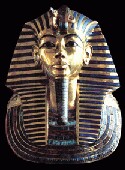- Skip Storing This Everyday Product in the Fridge Door
- Green Tea + B3 Pairing May Boost Brain Health
- Navigating Your Midlife Crisis: Embracing New Possibilities
- City Raccoons Showing Signs of Domestication
- Mapping the Exposome: Science Broadens Focus to Environmental Disease Triggers
- One Week Less on Social Media Linked to Better Mental Health
- Your Brain Changes in Stages as You Age, Study Finds
- Some Suicide Victims Show No Typical Warning Signs, Study Finds
- ByHeart Formula Faces Lawsuits After Babies Sickened With Botulism
- Switch to Vegan Diet Could Cut Your Greenhouse Gas Emissions in Half
Heart Disease Haunted Mummies, Too


Though the pyramids are proof of the ancient Egyptians’ architectural skills, new research on mummies tucked away inside them unearths a lesser known fact: heart disease was as common then as it is today.
Much to their surprise, when scientists did full-body CT scans of 4,000-year-old mummies they discovered evidence of hardening of the arteries.
“Atherosclerosis is supposed to be a disease of modern civilization,” said study author Dr. Adel Allam, a nuclear cardiologist and professor of cardiology at Al Azhar University in Cairo.
“It’s supposed to be explained by the fact that we’re eating all the wrong foods, not exercising enough, becoming obese and having diabetes. And a lot of people have said that if we could just go back to the way our ancestors were living we could even lose this problem,” he added.
“So, we wanted to find some way to see if this is true or not,” Allam said. “And by scanning the mummies we discovered that they had as much heart disease as we had.”
Allam and his colleagues presented their findings at the just-concluded American College of Cardiology annual meeting, in Washington, D.C.
Allam’s team actually broadened its initial focus to include naturally mummified specimens from other societies and socioeconomic backgrounds. In all, ancient samples were gathered from Lima, Peru; from the Aleutian people in Alaska; from Native Americans in Nevada; and from desert-dwellers in Mongolia.
“The idea,” said Allam, “was to deal with any criticism that the mummies of Egypt only represented a rich elite, who would’ve presumably eaten more fatty foods than the average ancient Egyptian.”
In all, the authors scanned 76 mummies from around the world. Arterial disease was found in roughly 38 percent of them, with the time of death pegged at an average age of about 37.
A comparative scan of 178 Cairo cancer patients was also conducted. These patients ranged in age from 14 to 84.
In the end, a much higher proportion of present-day Egyptians — approaching 61 percent — were found to have arterial hardening.
“So, at first it appeared that although we did find that atherosclerosis existed among ancient people, the disease is much more frequent and severe in modern man,” Allam said. “But we recognized that very few ancient Egyptians lived as long as we do today, which means that our Cairo patient sample was much older than the mummies,” he explained.
“So, what we did then was to remove all the patients who were above 60. And when we did that we had a much more interesting finding: there was no difference between the mummies and patients in terms of atherosclerosis incidence or severity,” Allam said.
“They were nearly equivalent,” he added. “And this was very, very striking. Because it was not only that the disease existed at that time, but that there was a big similarity with disease today.”
What does it all mean?
“We started this project because we wanted to learn from the dead in order to help the living,” Allam said. “And I think these findings may start to take us in a new direction. Because the fact is that if you look at all these mummies from all different places you see that they lived in many different ways and ate different diets, and yet in spite of it all they all got the disease as much, and in the same way, that we do today.”
Allam said this would suggest that “risk is not just about diet and obesity and not exercising. Certainly these are important. But it’s not the whole story. There’s a missing link here. There must be other factors. Perhaps inflammation, or perhaps genetics. Or most likely, as is usually the case in science, there are multiple factors that work together to get things started and lead to disease.”
Dr. Gregg Fonarow, a professor of cardiology at the University of California, Los Angeles, agreed that the cardiovascular similarities indicate that this “leading cause of death and disability globally” is probably driven by factors that go beyond nutrition and exercise.
“While atherosclerosis has been considered by some to just be a more recent problem resulting from unhealthy diets and inactive lifestyle, these studies suggest otherwise,” he said.
And, Fonarow added, “the presence of atherosclerosis in pre-modern and modern humans suggests there may be common predispositions to this disease process.”
Research presented at medical meetings should be viewed as preliminary until published in a peer-reviewed journal.
More information
Visit the American Heart Association for more on atherosclerosis.
Source: HealthDay
Copyright © 2025 HealthDay. All rights reserved.










